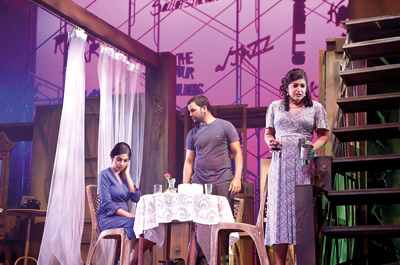The unkindness of strangers
So, what’s not to die for? I had long and earnestly awaited a bold producer’s courageous plunge to put on this iconic, most celebrated of Tennessee Williams’ plays. That The Workshop Players decided to stage it in celebration of the 60th Anniversary of the Lionel Wendt was a dream come true – finally. And it was with eager anticipation that we settled down in the hushed and untypically unpacked auditorium on the last night of this production.
In the first few minutes, two aspects stood out: a workable set (with the only redundancy being some under-utilized scaffolding, centre and back) and superlative lighting (which remained atmospheric throughout). As the action unfolded over a seemingly interminable two and a half hours or more, I began to miss some of what I had expected from a classic play by a master-craftsman playwright. Where was the tension, the terror, the bittersweet aftertaste of a marital (or Martial) spat salved by Venus?

Tortured relationships: Blanche (Bimsara Premaratne), Stanley (Mario de Soyza) and Stella (Shanuki de Alwis). Pix by Shehal Joseph
Perhaps a major contributor to a small but significant sense of anticlimax stemmed from contemporary socio-sexual realities. When Williams first outraged Stateside theatre audiences with his provocative Streetcar, homosexuality and spousal or incestuous rape were not only taboo, they were traumatic; today, we’ve become all but a bit blasé about ambivalent sexual orientations that cause connubial strife and even domestic violence.
In that sense, this interpretation provoked the desire, but took away some of the élan vital of a mature performance. A good deal of the blame must be laid at the door of whoever edited the script. You don’t tamper with Tennessee Williams’ most controversial lines without paying a price for the sake of propriety.
If an important theme of central character Blanche’s histrionics and eventual breakdown is her discovery of her young poet husband in flagrante delicto in another man’s arms, you don’t cut it out without repercussions. Blanche’s hysteria thereby lacked an edge.
Maybe this is unfair by the players. Bimsara Premaratne as the bird with two broken wings, Blanche DuBois, was valiant in her effort to sustain the madness for the duration of a tortuous near-three hours. If her diction had been more southern belle and less suburban elocution, she could have come off more admirably than she did.
In that respect, Shanuki de Alwis as kid sister Stella Kowalski was consistent at least in terms of her slow lazy drawl. Her take on a torn-between-two-haters wife/sister was equally measured, languid, and inflected. One also empathized with the gentlemanly charm of André Pereira’s Mitch Hubbell, although I am not at all sure that the character in the original script was not more macho?
The part was not nearly nuanced enough to climax in another near-rape scene, one between Mitch and Blanche, which would have counterpointed the assault and battery of Blanche by Stanley Kowalski (a suitably brute-like Mario de Soyza).
He was a true-blue Neanderthal; but de Soyza balanced a wounded machismo well with raw animality tempered by native cunning. (The only pity was that the direction required too many of the actors to rely heavily on cursing and shouting to create tension; for apart from the landmark ‘Hey, Stellaaaa!’, Stanley’s menace is more a strong, silent, stalking danger than mere aggression.)
Now don’t mistake my unflattering comments as unkindness. I’m not a stranger to either the play or the players. But there’s no getting away from the brickbats, as much as cast and crew would desire nothing but encomiums. As Blanche would say, “I’m not going to be hypocritical about it: I’m going to be honestly critical about it.”
That part done, I can also say thank you for the bold attempt, the brave execution, and the colourful interpretation. Maybe next time, a more faithful rendition of the script will add a certain je ne sais quoi that was strangely lacking in what was otherwise that rarity in local English-language theatre these days: a professional production put on by amateurs that pleased without appearing to try too hard.
Kudos to the artistic vision that picked this of all plays to engage and eviscerate us with. I for one walked out with a dull cold pain in my stomach. And it was not at all the misplaced standing ovation that brought on the cramps; but a dread realization that under our sophisticated veneers, we may all have a brute lurking or a bird with a broken wing trapped in a not so gilded cage.
Theatre review
- A Streetcar Named Desire
- By Tennessee Williams
- Presented by The Workshop Players
- Directed by Jerome L. De Silva
- The Lionel Wendt Auditorium
- July18–21, 2013
Follow @timesonlinelk
comments powered by Disqus


